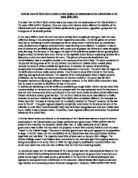National unity was another weakness evident within the liberal state. Cultural identity in Italy leading up to 1914 was limited because it lacked generalization and a consensus. The weakness in Culture was manifested by the general lack of social acceptance of the liberal state, as before the unification of Italy, each individual state had separate languages and customs. Through the unification a new cultural identity was branded upon the Italian People, but not generally accepted because of the greater problems they faced through the liberal state and a broad intellectual consensus was not met. Unification was not the result of one general uprising and some regions such as the Papal States felt that it had been imposed upon them. Many felt unification was incomplete because Austria still occupied the ‘unredeemed’ lands of Trentino and Trieste, while a blow was dealt to Italian pride by their defeat at the hands of the Abyssinians at Adowa in 1896. So therefore Italy was culturally and socially divided, as well as economically. This division and lack of consensus, accompanied with an ongoing lack of social unification was another fundamental weakness of the liberal state. This idea of national unity and the lack thereof is relevant to the North-South divide and education is drawn into this also, as most Italians spoke local dialects and rates of illiteracy were high, especially in the South as funds were sparsely invested into southern education. So therefore, national unity was a significant problem and another attribute, accompanied with it’s relevance to the North-South divide, that was detrimental to the liberal government.
Another key weakness of the Liberal government’s was its government and politics. Italy’s political governing system was deeply flawed as its stability was weakened by the use of Transformismo. Transformismo, being the political maneuver of where Italian politicians won support to create governments through bribery, favors and services to their deputies. Even though there was some evident attempts at progress in the governing system, these systematic jabs at improvement were completely undermined by the Italian people through the constant use of Transformismo as it created an impression to Italians that politics consisted of deals and bribery, for things that weren’t relative to the general needs of the Italian people, this therefore, alienated them furtherly from the political system. Also, Italy has a strong enemy of the state, the Mafia. The mafia had some influence and control in government through outside law corruption and bribery. This formed an alliance between crime and government, creating a very unstable governing system. This is a weakness without relation to the North-South divide; however, the mafia was present in mainly southern areas as the South had problems with crime and with things that create crime such as poverty and poor quality education. So therefore, the use of Transformismo and corrupt politics was a weakness within the governing state on its own which was detrimental to the liberal state. However again the government’s negligence of the south led to crime and subsequently a mafia and then and alliance between crime and government, a fundamental weakness of the liberal state.
Another key weakness of the liberal state was its remarkably low International reputation. International reputation is gathered from their international respect and successful diplomacy supported by military might, this aspect of Italy was poorly conceived and therefore was a weakness of the state. For example, Italy’s invasion of Libya was remarked internally as pointless, as it was a small country and resource-less. This was also emphasized due to the fact that it was the only ever defeat Italy had of another country. The Italian army was also renowned for it’s weakness as they often lost wars with their involvement. Also, through the invasion of Libya taxes were raised and conscription was introduced and resented. Through multiple losses and evident issues within their military arms Italy’s army was deemed poor by other countries. A bad international reputation gave Italy low internal morale and meant that Italy was seen outwardly as a weak country. This is yet another alternate explanation for the liberal states weaknesses. However, the internal problems caused by the military failures and subsequent low international reputation could questionably link yet again to the North- South divide itself. This is because the raises in taxes because of the war would have affected the South more so financially as they would already have been poverty stricken. Also, the reasons for going to war gave no benefits to the South, whom was conscripted regardless. So this would have made tensions within the divide more prominent, and the south’s financial position even more destitute, worsening the economic divide. Therefore, internal reputation and military failures were a significant attribute to the liberal states weaknesses.
In conclusion, the North-South divide was a very prominent issue as it reached into many different aspects of Italy’s state, and was the result of many ongoing problems/weaknesses as well. For example, The north-south divide was mainly conceived from Italy’s economic failures, however it was also a result of a lack of social/cultural unification, it was worsened by governmental negligence of the south and military failures. However, other unrelated problems were significant, such as the governments use of Transformismo and international reputation, which were also accountable for The weaknesses of the liberal state to an extent. However, it is fair to say that because of the broad causes of the North-south divide and the subsequent detrimental effects of it, it was a accountable to the weaknesses of the liberal state to a great extent.







